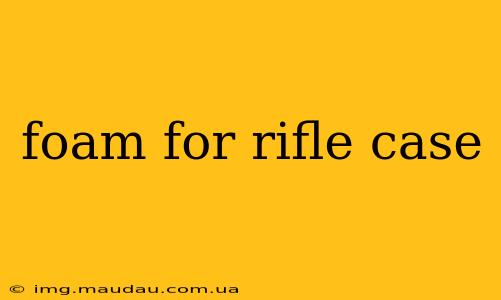Protecting your valuable firearm is paramount, and the right rifle case foam is crucial for ensuring its safe transport and storage. This guide will walk you through everything you need to know about choosing the best foam for your rifle case, covering different types, thicknesses, and customization options. Whether you're a seasoned hunter, a competitive shooter, or simply a responsible gun owner, understanding foam options is vital.
Types of Rifle Case Foam
Several types of foam offer varying levels of protection and customization. Let's explore the most common:
1. Pre-Cut Foam
Pre-cut foam offers convenience and immediate protection. Many cases come with pre-cut foam inserts specifically designed for certain firearm models. The advantages include:
- Ease of use: No cutting or shaping required.
- Ready-to-go protection: Provides immediate protection upon purchase.
- Cost-effective: Often the most budget-friendly option.
However, pre-cut foam might not be ideal if you have an unusual firearm or need a highly customized fit.
2. Pick and Pluck Foam
Pick and pluck foam offers exceptional customization. This type of foam features a grid of small cubes that can be easily removed to create a perfectly tailored fit for your firearm and accessories. Key benefits include:
- Customizability: Ideal for unique firearms and accessories.
- Precise fit: Creates a snug, secure fit for maximum protection.
- Versatile: Can be easily adapted as your needs change.
The downside is the time investment required to create the perfect configuration. It can be labor-intensive, especially for intricate firearm shapes.
3. Closed-Cell Foam
Closed-cell foam, like polyethylene foam, is known for its water-resistance and durability. This makes it an excellent choice for outdoor activities or harsh environments. Benefits include:
- Water Resistance: Protects your firearm from moisture damage.
- Durability: Withstands impacts and pressure better than some other foams.
- Lightweight: Adds minimal weight to your rifle case.
However, closed-cell foam can be more challenging to cut and shape than other options.
Choosing the Right Thickness
Foam thickness directly impacts the level of protection your rifle receives. Thicker foam provides superior cushioning and shock absorption. Consider:
- Rifle Type: Larger, heavier rifles require thicker foam for adequate protection.
- Transport Method: If you often transport your rifle by air or in rugged terrain, thicker foam is highly recommended.
- Case Size: Choose a foam thickness that fits comfortably within your rifle case, ensuring a snug but not overly compressed fit.
Customizing Your Foam
Whether you’re using pick and pluck or cutting your own foam, consider these customization tips for optimal protection:
- Multiple Layers: Using multiple layers of foam provides superior cushioning and shock absorption.
- Eye Protection: Ensure adequate foam surrounds the scope and other sensitive areas.
- Accessory Compartments: Create dedicated compartments for magazines, cleaning kits, and other accessories.
Maintaining Your Rifle Case Foam
To extend the life of your rifle case foam and maintain its protective qualities, follow these tips:
- Regular Inspection: Check for tears, dents, or compression.
- Cleaning: Use a mild detergent and water to clean any dirt or debris.
- Proper Storage: Store your rifle case in a cool, dry place away from direct sunlight.
Choosing the right foam for your rifle case is a critical step in protecting your investment. By carefully considering the factors discussed above—type, thickness, and customization—you can ensure your firearm stays safe and secure, no matter where your adventures take you. Remember to always prioritize safety and handle your firearms responsibly.
